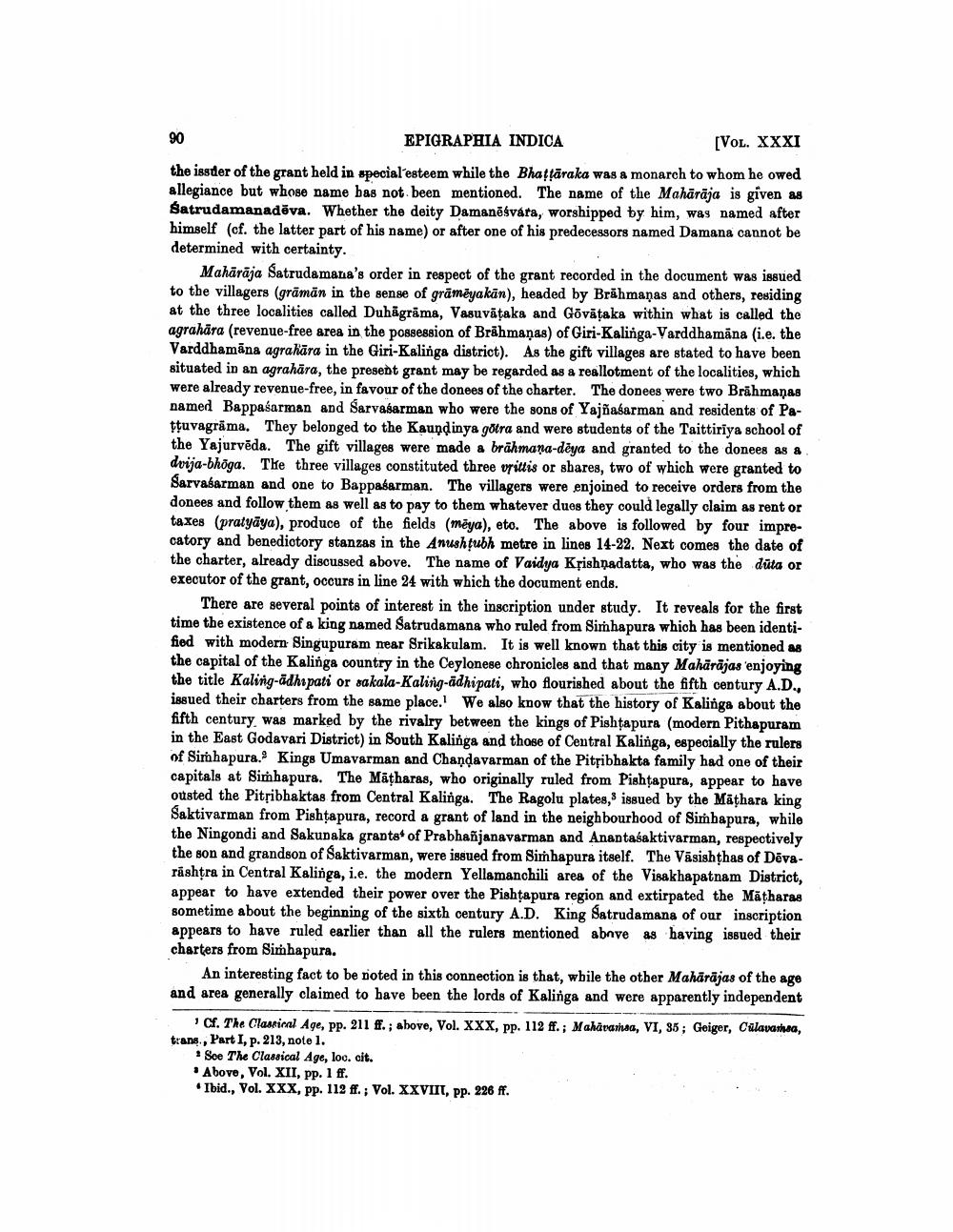________________
EPIGRAPHIA INDICA
[VOL. XXXI
the issder of the grant held in special esteem while the Bhaffäraka was a monarch to whom he owed allegiance but whose name bas not been mentioned. The name of the Mahārāja is given as Satrudamanadēva. Whether the deity Damanēsvára, worshipped by him, was named after himself (cf. the latter part of his name) or after one of his predecessors named Damana cannot be determined with certainty.
Mahārāja Satrudamana's order in respect of the grant recorded in the document was issued to the villagers (grämän in the sense of grāmēyakan), headed by Brāhmaṇas and others, residing at the three localities called Duhägrama, Vasuvāțaka and Govățaka within what is called the agrahāra (revenue-free area in the possession of Brāhmaṇas) of Giri-Kalinga-Varddhamāna (i.e. the Varddhamāna agrahāra in the Giri-Kalinga district). As the gift villages are stated to have been situated in an agrahāra, the present grant may be regarded as a reallotment of the localities, which were already revenue-free, in favour of the donees of the charter. The donees were two Brāhmaṇas named Bappaśarman and Sarvasarman who were the sons of Yajñaśarman and residents of Pattuvagrāma. They belonged to the Kaundinya götra and were students of the Taittiriya school of the Yajurvēda. The gift villages were made a brāhmana-deya and granted to the donees as & dvija-bhoga. The three villages constituted three vritis or sbares, two of which were granted to Sarvašarman and one to Bappaśarman. The villagers were enjoined to receive orders from the donees and follow them as well as to pay to them whatever dues they could legally claim as rent or taxes pratyāya), produce of the fields (meya), eto. The above is followed by four imprecatory and benediotory stanzas in the Anushtubh metre in lines 14-22. Next comes the date of the charter, already discussed above. The name of Vaidya Krishnadatta, who was the duta or executor of the grant, occurs in line 24 with which the document ends.
There are several points of interest in the inscription under study. It reveals for the first time the existence of a king named Satrudamana who ruled from Simhapura which has been identified with modern Singupuram near Srikakulam. It is well known that this city is mentioned as the capital of the Kalinga country in the Ceylonese chronicles and that many Mahārājas enjoying the title Kaling-adhipati or sakala-Kaling-adhipati, who flourished about the fifth century A.D., issued their charters from the same place. We also know that the history of Kalinga about the fifth century was marked by the rivalry between the kings of Pishtapura (modern Pithapuram in the East Godavari District) in South Kalinga and those of Central Kalinga, especially the rulers of Simhapura. Kings Umavarman and Chandavarman of the Pitfibhakta family had one of their capitals at Simhapura. The Mātharas, who originally ruled from Pishtapura, appear to have ousted the Pitsibhaktas from Central Kalinga. The Ragolu plates, issued by the Mathara king Saktivarman from Pishtapura, record a grant of land in the neighbourhood of Simbapura, while the Ningondi and Sakunaka grants of Prabhañjanavarman and Anantasaktivarman, respectively the son and grandson of Saktivarman, were issued from Simhapura itself. The Vāsishthas of Dövarashtra in Central Kalinga, i.e. the modern Yellamanchili area of the Visakhapatnam District, appear to have extended their power over the Pishtapura region and extirpated the Mäţharas sometime about the beginning of the sixth century A.D. King Satrudamans of our inscription appears to have ruled earlier than all the rulers mentioned abnve as having issued their charters from Simhapura.
An interesting fact to be noted in this connection is that, while the other Mahārājas of the age and area generally claimed to have been the lords of Kalinga and were apparently independent
Cf. The Classical Age, pp. 211 f.; above, Vol. XXX, pp. 112 ff.; Maharamsa, VI, 35; Geiger, Calavansa, trans., Part I, p. 213, note l.
* Soe The Classical Age, loc. cit. . Above, Vol. XII, pp. 1 ff. • Ibid., Vol. XXX, pp. 112 ff.; Vol. XXVIIT, pp. 226 ff.




